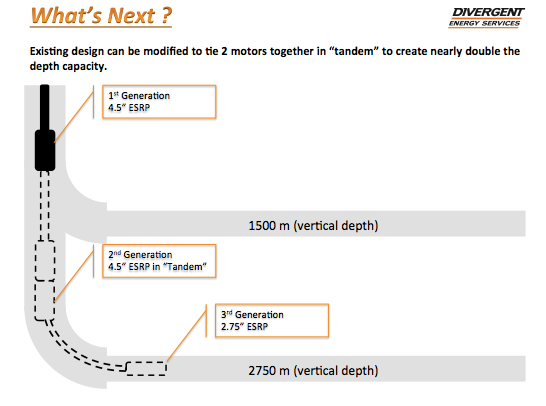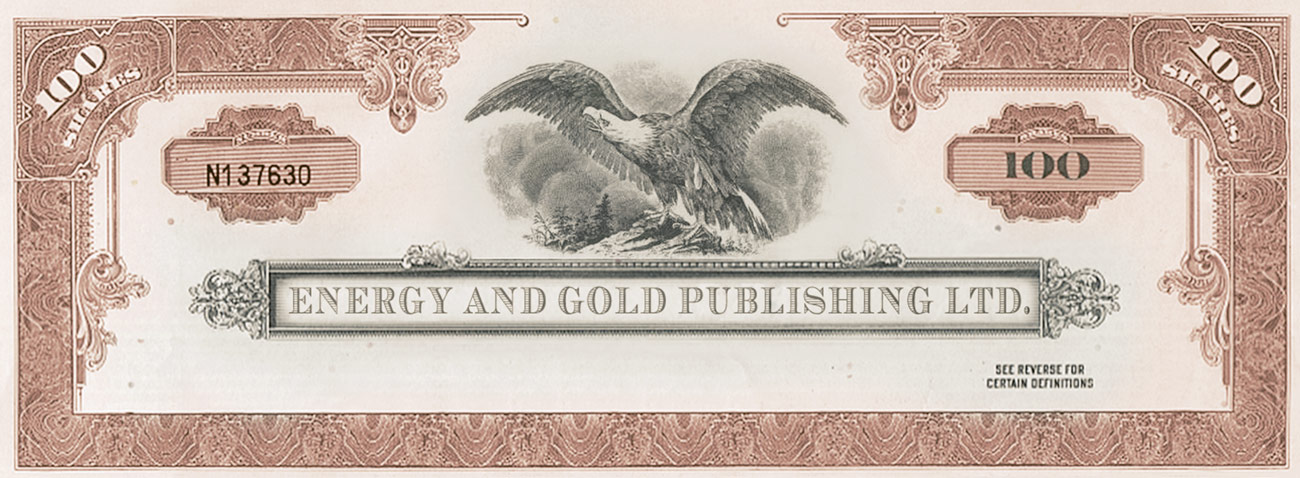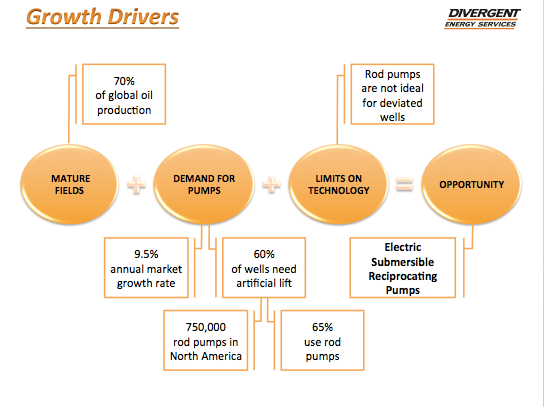It’s no secret the oil and gas industry is on the ropes. A greater than 50% correction in the price of oil in late 2014 has producers scrambling to lower costs.
One company, Divergent Energy Services (TSXV:DVG), has a simple product that saves energy firms a ton of cash. It’s a business that’s also highly scalable.
Divergent has created a submersible pump that eliminates the need for large, maintenance heavy pump jacks. These old pump jacks can have all sorts of expensive mechanical issues.
The company’s Calgary based Chief Executive, Mr. Ken Berg, sat down with Energy and Gold recently to discuss the Divergent investment opportunity.
Scott Armstrong: Please tell our readers about Divergent, what is your technology and what gives you a competitive advantage?

Ken Berg: Divergent Energy Services operates in the artificial lift space of the oil & gas industry. More specifically we operate with electric submersible pumps. Our core business puts in conventional electrical submersible pumps pumping oil, water and condensates. But the focus of the organization is in the development and deployment of innovative and disruptive technologies. The one we are focused on right now is using rare earth magnets which create a submersible pump that reciprocates rather than rotates. A conventional pump spins at about 3,000 RPM, this doesn’t spin at all, it reciprocates using a magnetic thrust concept. Similar to a high speed train being thrust down the track, this is a low speed version of that.
One of the big cost drivers operating an oil well now is the maintenance of the rods that hang below the pump jack. So the pump jack on the surface moves up and down all day and there’s a metal rod that hangs all the way to the bottom of the hole and actuates the pump. Now no well is drilled perfectly straight and the more deviated the well is drilled the more costly it is to operate because that rod is rubbing and fatiguing down the wellbore. So every place, as the well gently spirals down to say 1500 meters, that the rod touches the side of the tubing,is eventually going to wear and break. We are developing a motor that will attach directly to the same type of pump at the bottom of the hole, removing all the surface equipment and those rod strings, leaving only the pump directly driven by a magnetic motor at the bottom of the hole.

Scott Armstrong: How does your maintenance program differ from what is currently required for your average Pump Jack and how does it save your client time and money?
Ken Berg: There will be a similar maintenance program for the pump section. The pumps today will remain relatively the same, what’s changing is removal of those rod strings which are an additional maintenance item. The pump itself will still have no more lifespan than it does today. It still suffers mostly from erosion when you produce sands or silts in the wellbore. Just over time it’s going to wear out and that’s no different. The real costly part is when those rods fail and the biggest cost is that you’re not producing oil anymore. The client we’re working with to deploy the prototype estimates that they’re losing 5 days of oil production per failure.
Scott Armstrong: What is your personal experience in this field, how did you get involved in developing new pumping technology?
Ken Berg: My background is in mechanical engineering, I worked in the E&P side for Dome Petroleum which was bought out in the largest acquisition of its time by Amoco. In 1992 I switched to the service side, I went to a small private company, Sanjel Corporation which was a small up and coming cementing company. I spent 20 years there doing engineering and sales, for the last half of that I was VP for sales. From the time I was there it was about a 1400% increase in revenues.
Scott Armstrong: How did you get involved with Divergent?
Ken Berg: I had taken a couple months off after Sanjel and I’d been researching the industry trying to decide which segment I wanted to come back in. The artificial lift segment is one of the few forecasted to be increasing, it’s not independent of the oil price but it is well sheltered from it. A company that was doing an equity raise for Divergent in 2012 had asked me if I wanted to become an investor, and after meeting the company I also ended up taking a seat on the board and became an officer of the company. I ran into this engineer from the US and he had been following this permanent magnet motor technology, he proposed that if I joined Divergent he would come work for me. It’s taken longer than expected but we have achieved what we set out to do. Now we’re at the prototype stage where we’ve got a finished product in our hands and we are ready to go.
Scott Armstrong: How sheltered are you to the recent oil & gas sector downturn?
Ken Berg: We are largely sheltered from the downturn in the oil price. It generally affects a little more upstream, drilling & completions. We are not looking to deploy this in brand new wellbores at this point. We are looking at wellbores that are at least one year old and the production rates have declined to within the pumping range that this pump can handle. For example the reservoir we are going into in Saskatchewan the initial production could be 500 barrels/day but in a year or two that production is only going to be 100 barrels/day, that’s right in the wheelhouse of our pump.
CEO Technician: Can you give our readers some sense of how much your technology can potentially save a client?
Ken Berg: That is largely dependent on the failure rate. It wouldn’t be uncommon to be out to an oil well 4 times per year. The average annual maintenance cost and lost production would be about $160,000 (at 50 barrels/day and $50/barrel). What we are really going after is highly deviated wellbores and horizontal wellbores. Pump jacks are a very tough sell in the horizontal well market because now you’re taking that metal rod and bending it 90 degrees from the vertical to the horizontal and you’re going to move that up and down 3 million times/year so the rate of fatigue is going to be crazy.
Scott Armstrong: You mentioned you are in the prototype phase right now but could share with us how many units you have in production?
Ken Berg: We are on the cusp right now of deploying a 3 well pilot test. So we have people out in the field right now who are working on deploying the first one.
Scott Armstrong: What is your vision for Divergent? Where do you see the company 2-3 years down the road?
Ken Berg: The vision is to take this technology, duplicate the operations we already have in Gilette, Wyoming because the nature of the work they do there is exactly what we will need to do with the new pump. I see us being in another half a dozen locations within 2-3 years, Saskatchewan, Alberta, Utah, potentially Montana. There are a wide range of low hanging fruit reservoirs out there that produce good quality light crude that’s easy to work with, with production rates that are within the window of our pump’s capacity and these wells all have pump jacks on them and they are all costing these oil companies money.
Scott Armstrong: How long does it take if for a client to convert from a Pump Jack to a Divergent Submersible Mag pump?
Ken Berg: It would be a 3 day operation. The first day would be removing all the existing equipment, the second day would be deploying our equipment, and the third day is where the electricians are out installing the control panel and we turn it on.
The real key around this is not just replacing existing pump jacks out there. If you know that you are going to adopt this technology you would start to put a plan in place that said “we have X number of pump jacks that we own already, we know what we are going drill say 100 wells and the pump jacks are capable of large volumes of oil. Lets keep those pump jacks and move them to the new wells and every time we move a pump jack to a new well we will backfill it with one of Divergent’s pumps”. It’s anticipated to be capital neutral to the oil company, they’re going to drop money on a pump jack installation but instead of doing that they shift that same capital expenditure to a Divergent pump. By doing this, bit by bit they reduce their overall lifting cost of oil because now they’re slowly removing the rod strings from their inventory.
CEO Technician: When do you see Divergent turning a profit? I noticed that you are close but not quite there yet. And do you foresee a need to raise capital in the near future?
Ken Berg: If we hit all of our targets we could be cash flow positive in 2015. However, the unknown right now is the rate of adoption of a new technology. By 2016 I think we will be long past the early adopters and have some pace increase, I would hope that by 2016 we will be cash flow positive. And yes, we will be needing to raise capital within 3-6 months as we transition into the early commercialization phase. We haven’t fine tuned it but our discussions internally are around the $5 million range.
CEO Technician: What is the amount of insider ownership in Divergent? And how many shares do you personally own?
Ken Berg: Right now the insiders own 6.6% of the outstanding shares and I own roughly 3 million shares myself.
Scott Armstrong: Is your technology proprietary or who are your competitors?
Ken Berg: There’s another company in Edmonton that’s been trying for 3-4 years to get a similar product to work. I actually bought one of their motors from a different Chinese manufacturer (the one they are working with) and it didn’t run smoothly, it had a lot of cogging. We tried to get them to adopt our ideas to make it run better and they just wouldn’t listen. The company we are currently partnered with, we came across them a short time later, and they were much more open and listened to our ideas.
Do I think we will be the only people in the market? No I don’t, but I think we will be the first successful implementation and commercialization of this technology. Fortunately we are very well connected in the Canadian market, in Wyoming, and PEMEX (Mexico) loves us.
We would like to thank Ken for his time and we see a bright future for Divergent. We will be following the company closely over the coming months.
This article contains forward-looking statements, including, without limitation, statements pertaining to the installation of additional hardware and the starting of the Pump. All statements included herein, other than statements of historical fact, are forward-looking information and such information involves various risks and uncertainties. There can be no assurance that such information will prove to be accurate, and actual results and future events could differ materially from those anticipated in such information. A description of assumptions used to develop such forward-looking information and a description of risk factors that may cause actual results to differ materially from forward-looking information can be found in Divergent’s disclosure documents on the SEDAR website at www.sedar.com. Forward-looking statements are based on estimates and opinions of
management of Divergent at the time the information is presented. Divergent may, as considered necessary in the circumstances, update or revise such forward-looking statements, whether as a result of new information, future events or otherwise, but Divergent undertakes no obligation to update or revise any forward-looking statements, except as required by applicable securities laws.


